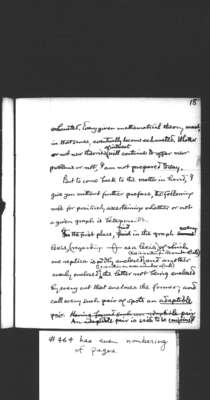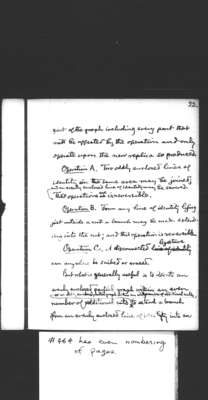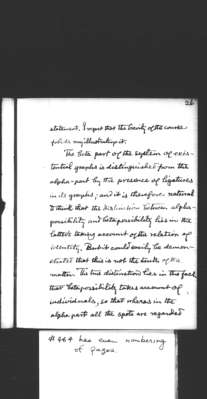Pages
11
18
exhausted. Every given mathematical theory must, in that sense, eventually become exhausted. Whether or not new theories of interest will continue to offer new problems or not, I am not prepared to say.
But to come back to the matter in hand, I give you without further preface, the following rule for positively ascertaining whether or not a given graph is beta possible.
In the first place, find in the graph every lexis, (regarding as a lexis,) of which one replica is oddly enclosed (that is, is within an odd number of cuts) and another evenly enclosed, (i.e. is within an even number of cuts) the latter not being enclosed by every cut that encloses the former; and call every such pair of spots an adaptible pair. Having found such an adaptible pair An adaptible pair is said to be conjoined
12
20
when, and only when, every hook of one of its spots is joined by a ligature to the corresponding hook of the other spot. Your object will be as far as possible to leave no adaptible pair unconjoined, and if this be impossible, at any rate to produce every possible combination of conjunctions in some replica of an evenly enclosed part of the graph, unless you can see clearly that nothing would be gained by a given combination would not serve your purpose in any degree. In order to do this you are permitted to perform any of the following operations upon ligatures, provided that before performing any a non-reversible operation you iterate an evenly enclosed
13
22
part of the graph including every part that will be affected by the operation and only operate upon the new replica so produced.
Operation A Two oddly enclosed lines of identity on the same area may be joined; and an evenly enclosed line of identity may be severed. These operations are irreversible.
Operation B. From any line of identity lying just outside a cut a branch may be made extending into the cut; and this operation is reversible.
Operation C. A disconnected line of identity ligature can anywhere be scribed or erased.
But what is generally useful is to iterate an evenly enclosed partial graph within an even number of additional cuts, or an oddly enclosed partial graph within an odd number of additional cuts, to extend a branch from an evenly enclosed line of identity into an
14
24
an odd number of cuts and there join it to another, to get rid of an oddly enclosed replica, and to erase an evenly enclosed replica of the same graph. Of course, this operation is irreversible.
Secondly, when all possible combinations of conjunctions of applicable pairs have been made, the second part of the rule is to be applied, all spots not conjoined by all their corresponding hooks being treated as replicas of different lexeis and all spots that are so conjoined being treated as replicas of the same lexis, and no further attention being paid to the ligatures during the process.
The process will be found to be simpler in practice than it sounds in an abstract
15
26
statement. I regret that the brevity of the course forbids my illustrating it.
The beta part of the system of existential graphs is distinguished from the alpha-part by the presence of ligatures in its graphs; and it is therefore natural to think that the distinction between alpha possibility and beta possibility lies in the latter's taking account of the relation of identity. But it could easily be demonstrated that this is not the truth of the matter. The true distinction lies in the fact that beta possibility takes account of individuals, so that whereas in the alpha part all the spots are regarded




